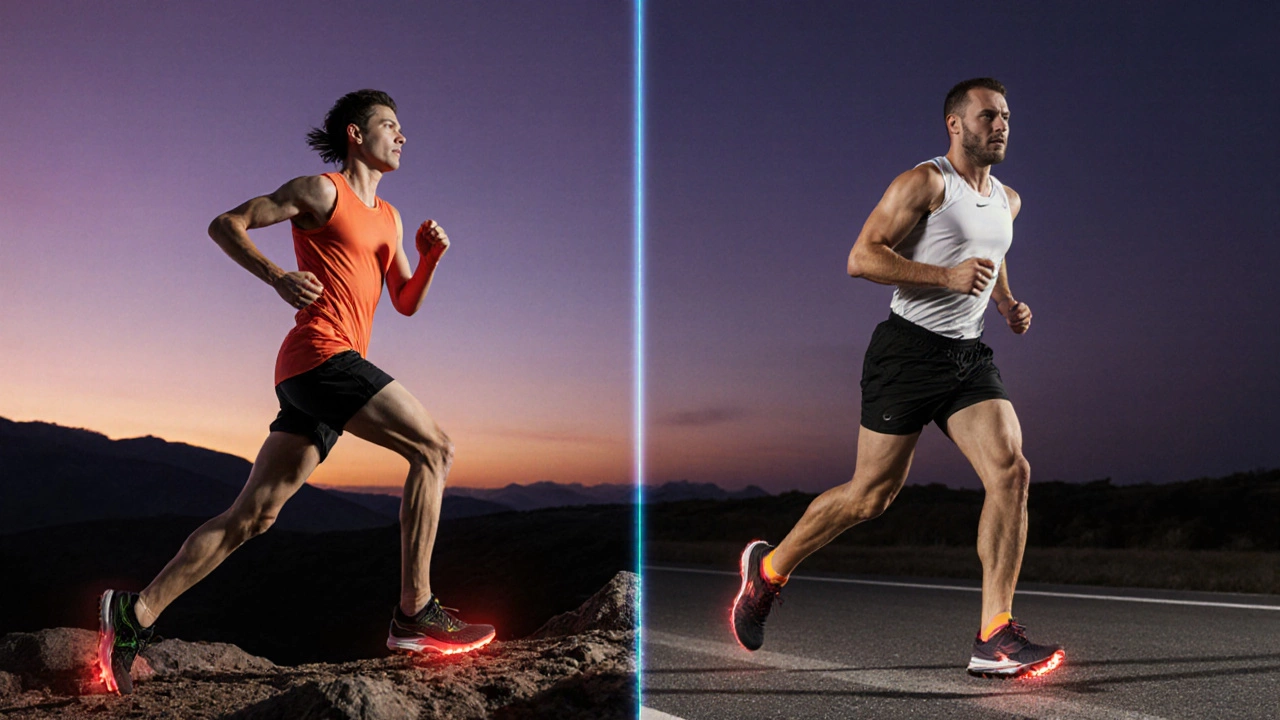XC Running Efficiency Calculator
How Weight Affects Your Race Time
Cross-country runners optimize for power-to-weight ratio. For every kilogram of body fat lost (not muscle), runners can improve their 5K time by 1-2 seconds.
Ever watched a cross-country race and wondered why these runners look so lean? Like they could vanish in a breeze? It’s not just about eating less or starving themselves. There’s a whole science behind why XC runners are built the way they are - and it’s not random. It’s evolution, training, and physics working together.
It’s Not About Being Skinny - It’s About Power-to-Weight Ratio
Runners don’t aim to be thin. They aim to be efficient. In cross-country, every extra pound matters. Think of it like climbing a mountain with a backpack. The heavier the pack, the more energy you burn just to move. XC runners carry no extra weight because their bodies have adapted to move fast over rough, hilly terrain for long distances.
Studies show that for every kilogram of body weight lost (as long as it’s fat, not muscle), a runner can improve their 5K time by about 1-2 seconds. In a race decided by seconds, that adds up. A 60kg runner with the same VO2 max as a 70kg runner will outperform them every time on hilly trails.
This isn’t about looking a certain way. It’s about survival. Your body doesn’t keep unused weight. If you’re running 80-120 kilometers a week over mud, roots, and hills, your body says: ‘Why carry extra muscle that doesn’t help me go faster?’
Training That Burns Fat and Builds Lean Muscle
XC training isn’t like road running. It’s harder. Trails are uneven. You’re climbing steep hills, jumping over logs, slipping on wet roots. Your body doesn’t have the luxury of smooth pavement. It has to work harder - and burn more calories.
Most elite XC runners train six days a week. A typical week includes:
- Two long runs (15-25 km)
- Two interval sessions (hill repeats, tempo runs)
- One easy recovery run
- One strength session (core, glutes, balance)
That’s 80-120 kilometers of running per week. Even if you eat 3,000 calories a day, your body is burning 5,000-7,000. That’s a deficit. And your body adapts by shedding fat - and any muscle that isn’t directly helping you run.
They’re not lifting heavy weights like bodybuilders. They’re doing bodyweight circuits: lunges, single-leg squats, planks, jump rope. Their muscles are dense, wiry, and built for endurance - not size. Think of them like a racing bike: light frame, no extra parts, all tuned for speed.
Genetics Play a Big Role - But Not the Whole Story
Let’s be real: not everyone can become a skinny XC runner. Genetics matter. Many elite cross-country runners come from East African populations - particularly from Kenya and Ethiopia - where the average person has naturally slender builds, long legs, and high metabolic efficiency.
These populations have evolved over centuries in high-altitude environments where oxygen is thin. Their bodies are optimized for endurance: higher red blood cell counts, more slow-twitch muscle fibers, and lower body fat percentages from birth.
But genetics aren’t destiny. You don’t need to be Kenyan to look like one. Many European and American runners achieve similar physiques through years of consistent training and diet. The difference? It takes longer. And it’s harder.
What matters most is your training volume and intensity. If you’re running 100 km a week and eating clean, your body will change - no matter your background.
Diet: What They Eat (And What They Don’t)
XC runners don’t diet. They fuel. But they’re very selective.
They eat:
- Complex carbs: oats, brown rice, sweet potatoes
- Lean protein: eggs, chicken, fish, lentils
- Healthy fats: nuts, avocado, olive oil
- Fruits and vegetables: tons of them
They avoid:
- Sugary snacks and sodas
- Processed foods with trans fats
- Excess alcohol
- Large meals right before training
They eat frequently - 5-6 small meals a day - to keep energy steady without bloating. Their meals are timed around training: carbs before, protein after. No fads. No keto. No juice cleanses. Just food that helps them run faster and recover quicker.
One pro runner I spoke to in Bangalore told me: ‘I don’t count calories. I count how fast I feel the next day. If I ate junk, I’d feel heavy. So I don’t.’
Why Don’t Other Runners Look Like This?
Marathoners? They’re lean too - but not always as skinny as XC runners. Why? Because marathons are flat. Less terrain variation. Less need for explosive power on hills. So they can carry a little more muscle mass for endurance.
Sprinters? They’re muscular. They need power, not efficiency. Their bodies are built to explode - not sustain.
Trail runners? They’re similar to XC runners, but often a bit heavier. Why? Because they carry gear. And trails can be less technical than XC courses. They need strength for stability, not just speed.
XC runners are the most specialized. Their courses demand lightness, agility, and constant acceleration. Every stride matters. Every gram counts.

Is Being Skinny Healthy for Runners?
Here’s the dark side: some runners push too far. They become dangerously thin. Their bones weaken. Their periods stop. Their immune systems crash. This is called Relative Energy Deficiency in Sport (RED-S).
It’s not about being skinny. It’s about being under-fueled. The body starts eating itself - muscle, organs, even bone density. That’s not fitness. That’s damage.
Elite coaches now monitor body composition with DEXA scans and blood tests. They don’t just look at weight. They look at fat percentage, hormone levels, and recovery markers.
A healthy XC runner isn’t skin and bones. They’re lean, strong, and energized. Their skin glows. Their eyes are bright. They sleep well. They recover fast. That’s the goal - not a number on a scale.
Can You Get That Body? Yes - But It Takes Time
If you’re a beginner runner and want to look like an XC athlete, don’t rush. Start with consistency. Run three times a week. Add one hill session. Eat whole foods. Sleep 7-8 hours. Cut out sugar.
After six months, you’ll notice changes. Your legs feel lighter. Your breathing improves. You start enjoying longer runs.
After two years? You might look like them. Not because you tried to be skinny. But because you trained hard, ate smart, and let your body adapt.
It’s not magic. It’s biology. Your body responds to what you ask it to do. If you ask it to run long, fast, and hard over rough ground - it will shed what it doesn’t need.
So next time you see an XC runner and think, ‘Wow, they’re so skinny,’ remember: they’re not trying to be thin. They’re trying to be fast. And their bodies did the rest.
Do XC runners lift weights?
Yes, but not like bodybuilders. XC runners do light strength work - bodyweight exercises like lunges, single-leg squats, planks, and resistance band drills. The goal is to build stability and prevent injury, not to add bulk. Heavy lifting can slow them down, so they focus on functional strength that supports running form.
Can women be skinny like male XC runners?
Absolutely. Female XC runners often have even lower body fat percentages than men - around 10-14% compared to 12-16% in men. But they need more fat for hormonal health. Coaches monitor female athletes closely to avoid RED-S. Healthy female runners aren’t emaciated - they’re lean, strong, and energized.
Is it safe to try to lose weight to look like an XC runner?
No - if you’re not already training heavily. Trying to lose weight without matching training volume can lead to injury, fatigue, or hormonal issues. Weight loss should come from increased activity and better food choices - not restriction. If you’re new to running, focus on building endurance first. Your body will naturally adapt over time.
Do XC runners eat less than other athletes?
Not necessarily. Many XC runners eat 3,000-5,000 calories a day - more than the average person. But they burn even more. Their meals are nutrient-dense, not calorie-dense. They avoid empty calories like soda and chips. It’s not about eating less - it’s about eating the right things.
What’s the difference between XC runners and marathoners?
Marathoners run on flat, paved roads for 42.2 km. XC runners run 8-12 km on uneven, hilly trails. XC demands more agility, explosive power, and quick directional changes. That’s why XC runners are often lighter and more compact. Marathoners can carry slightly more muscle for sustained pacing. Both are lean - but for different reasons.
If you want to run like an XC athlete, don’t chase thinness. Chase consistency. Train hard. Eat clean. Rest well. The body will take care of the rest.

